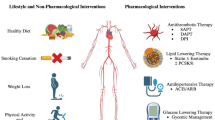Summary
BACKGROUND: A hospital-based screening project (HSP) in Austria found 47% of high-risk patients (LDL-C < 100 mg/dl) and 24% of very high-risk patients (LDL-C < 70 mg/dl) at goal. Separate data for the sexes were not reported. We analyze whether LDL-C goal attainment in patients with manifest atherosclerosis and/or diabetes on stable lipid-lowering treatment differs between private practice and hospital and between men and women. PATIENTS AND METHODS: From September to November 2007, 49 Austrian centers (36 private practice, 13 hospitals) documented vascular morbidity, lipid levels, and lipid lowering treatment in patients with high risk (atherosclerosis or diabetes, n = 978) and very high risk (coronary heart disease and diabetes or acute coronary syndrome, n = 322). RESULTS: 75% and 25% of the 1300 patients were high and very high risk, respectively. LDL-C goals of < 100 and < 70 mg/dl, respectively, were attained by 45.4% and 26.4% of patients (p < 0.001). A similar percentage of patients with very high risk was found in men and women (26.4% vs. 22.9%, NS) and goal attainment was not influenced by sex (high risk: 47.2% (m) vs. 43.8% (w), NS and very high risk: 29.1% (m) vs. 22.4% (w), NS). In patients with high risk, 41.6% treated in private practice vs. 57.9% treated in the hospital were at goal (p < 0.001). In patients with very high risk, 15.9% treated in private practice vs. 45.2% treated in the hospital were at goal (p < 0.001). Lower goal-attainment in private practice occurred despite significantly more intensive lipid intervention and probably reflects higher baseline LDL-C. LDL-C > 100 mg/dl leads to a more aggressive lipid lowering in approx. 70% of patients, irrespective of whether they are treated in private practice or in the hospital. LDL-C between 70 and 100 mg/dl, however, leads to a more aggressive lipid lowering in < 5% of patients, irrespective of whether they are high or very high risk. CONCLUSION: As observed in EUROASPIRE III for other European countries, there is substantial potential for improvement in lipid control in Austrian cardiovascular high-risk patients, irrespective of whether they are treated in private practice or in the hospital.
Zusammenfassung
HINTERGRUND: Ein spital-basiertes Screening Projekt (HSP) in Österreich dokumentierte eine LDL-C Zielwert-Erreichung von 47% der Hochrisikopatienten (Ziel < 100 mg/dl) und 24% der Höchstrisikopatienten (Ziel < 70 mg/dl) ohne getrennte Angaben zu Männern und Frauen. Unsere Untersuchung prüft, ob sich die Zielwert-Erreichung bei Patienten mit klinisch manifester Atherosklerose und/oder Diabetes mellitus (DM) in einer stabilen Behandlungssituation mit Lipidsenkern zwischen Spital und Praxis und zwischen Männern und Frauen unterscheidet. PATIENTEN UND METHODE: In 49 österreichischen Zentren (36 niedergelassene Ärzte, 13 Spitalsärzte) wurde von September bis November 2007 vaskuläre Morbidität, Lipid- und Therapiestatus bei Patienten mit hohem Risiko (Atherosklerose oder DM, n = 978) und höchstem Risiko (KHK und DM oder akutes Koronarsyndrom, n = 322) erhoben und die Zielwert-Erreichung dokumentiert. ERGEBNISSE: Von den 1300 Patienten wiesen 75% hohes und 25% höchstes Risiko auf, wobei die LDL-C Ziele in 45,4% bzw. 26,4% der Patienten erreicht wurden (p < 0,001). Männer und Frauen wiesen einen vergleichbaren Anteil an Höchstrisikopatienten (26,4% (M) vs. 22,9% (F), NS) und eine vergleichbare Zielwerterreichung (hohes Risiko: 47,2% (M) vs. 43,8% (F), NS und höchstes Risiko: 29,1% (M) vs. 22,4% (F), NS) auf. Bei hohem Risiko wurden die Ziele in der Praxis bei 41,6% vs. im Spital bei 57,9% erreicht (p < 0,001), bei höchstem Risiko in der Praxis bei 15,9% vs. im Spital bei 45,2% erreicht (p < 0,001). Die niedrigere Zielwert-Erreichung in der Praxis trotz intensiverer Lipidintervention dürfte durch ein ungünstigeres Ausgangslipidprofil erklärbar sein. Sowohl im Spital als auch in der Praxis erfolgt bei LDL-C>100 mg/dl bei ca. 70% der Patienten eine Therapie-Intensivierung, meist durch Wechsel auf ein hochpotentes Statin. Bei LDL-C zwischen 70–100 mg/dl erfolgt jedoch weder bei Hoch- noch bei Höchstrisikopatienten eine Therapie-Intensivierung (< 5%). SCHLUSSFOLGERUNG: Sowohl in der Praxis als auch im Spital in Österreich besteht, weitgehend parallel zu europäischen Analysen, weiterhin beträchtliches Verbesserungspotential in der Lipidzielwert-Erreichung bei kardiovaskulären Hoch- und Höchstrisikopatienten.
Similar content being viewed by others
Literatur
EUROASPIRE I and II Group. Clinical reality of coronary prevention guidelines: a comparison of EUROASPIRE I and II in nine countries. Lancet 2001;357:995–1001
Kotseva K, Wood D, De Backer G, De Bacquer D, Pyörälä K, Keil U for the EUROASPIRE Study Group. Cardiovascular prevention guidelines in daily practice: a comparison of EUROASPIRE I, II, and III in eight European countries. Lancet 2009;373:929–40
Roden M, Huber K, für die HSP-Projektgruppe. Lipidprofil und Therapiestatus in der Sekundärprävention bei Hochrisiko-Patienten mit klinisch manifester Arteriosklerose und/oder Diabetes mellitus: Das Hospital Screening Projekt (HSP) in Österreich. Wien Klin Wochenschr 2008;120:558–65
Grundy SM, Cleeman JI, Merz CNB, Brewer HB Jr, Clark LT, Hunninghake DB, et al. Implications of recent clinical trials for the National Cholesterol Education Program Adult Treatment Panel III Guidelines. Circulation 2004;110:227–39
Patsch JR, Föger B. AAS Cholesterinkonsensus 2006. www.aas.at/aktuelles
Winkelmayer WC, Bucsics AE, Schautzer A, Wieninger P, Pogantsch M, Pharmaeconomics Advisory Council of the Austrian Sickness Funds. Use of recommended medications after myocardial infarction in Austria. Eur J Epidemiol 2008;23:153–62
Pichler M, Eber B, Pfeiffer KP, Toplak H. ACT-Studie: Therapieziele verfehlt. Österr Ärztezeitung 2006;19:60–5
Baigent C, Keech A, Kearney PM, Blackwell L, Buck G, Pollicino C, et al. Efficacy and safety of cholesterol-lowering treatment: prospective meta-analysis of data from 90,056 participants in 14 randomised trials of statins. Lancet 2005;366:1267–78
LaRosa JC, Grundy SM, Waters DD, Shear C, Barter P, Fruchart JC, et al. Intensive lipid lowering with atorvastatin in patients with stable coronary disease. NEJM 2005;352:1425–35
Pedersen TR, Faergeman O, Kastelein JJP, Olsson AG, Tikkanen MJ, Holme I, et al. High-dose atorvastatin vs usual dose simvastatin for secondary prevention after myocardial infarction. JAMA 2005;294:2437–45
Author information
Authors and Affiliations
Corresponding author
Rights and permissions
About this article
Cite this article
Föger, B., Patsch, J. LDL-Cholesterin in der Sekundärprävention: Zielwert-Erreichung unter Lipidsenkern in Praxis und Spital in Österreich (ZIEL). Wien Klin Wochenschr 123, 21–27 (2011). https://doi.org/10.1007/s00508-010-1498-7
Received:
Accepted:
Published:
Issue Date:
DOI: https://doi.org/10.1007/s00508-010-1498-7




